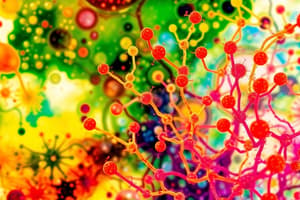Podcast
Questions and Answers
What are the three primary mechanisms for generating metabolic energy in microorganisms?
What are the three primary mechanisms for generating metabolic energy in microorganisms?
The three primary mechanisms for generating metabolic energy in microorganisms are fermentation, respiration, and photosynthesis.
Explain the role of nutrients in the cultivation of microorganisms.
Explain the role of nutrients in the cultivation of microorganisms.
Nutrients provide the necessary building blocks for microorganisms to synthesize macromolecules and maintain essential chemical gradients across their membranes.
What is the significance of isolating microorganisms in pure culture?
What is the significance of isolating microorganisms in pure culture?
Isolation of microorganisms in pure culture allows for the study of individual species without interference from other microorganisms.
Describe the two main considerations for cultivating microorganisms.
Describe the two main considerations for cultivating microorganisms.
Why is agar the ideal gelling agent for most microbial media?
Why is agar the ideal gelling agent for most microbial media?
How does the dilution method work for isolating microorganisms?
How does the dilution method work for isolating microorganisms?
Explain how the plating method is used to isolate microorganisms.
Explain how the plating method is used to isolate microorganisms.
What are the factors that must be controlled during the growth of microorganisms?
What are the factors that must be controlled during the growth of microorganisms?
Describe the relationship between growth and death in the natural environment for microorganisms.
Describe the relationship between growth and death in the natural environment for microorganisms.
Why is the cultivation of microorganisms essential in various fields?
Why is the cultivation of microorganisms essential in various fields?
Explain why the lag phase of bacterial growth is essential for the survival of bacteria.
Explain why the lag phase of bacterial growth is essential for the survival of bacteria.
What are the key factors that influence the duration of the lag phase in bacterial growth?
What are the key factors that influence the duration of the lag phase in bacterial growth?
Describe the main characteristics of the exponential phase of bacterial growth.
Describe the main characteristics of the exponential phase of bacterial growth.
Why are bacteria in the exponential phase particularly sensitive to antibiotics and environmental changes?
Why are bacteria in the exponential phase particularly sensitive to antibiotics and environmental changes?
What are the main processes occurring during the stationary phase of bacterial growth?
What are the main processes occurring during the stationary phase of bacterial growth?
Explain the role of nutrient availability in the transition from the exponential phase to the decline phase.
Explain the role of nutrient availability in the transition from the exponential phase to the decline phase.
Describe how bacterial survival in the decline phase can be facilitated.
Describe how bacterial survival in the decline phase can be facilitated.
What is the significance of maintaining bacterial cultures in the exponential phase for research purposes?
What is the significance of maintaining bacterial cultures in the exponential phase for research purposes?
Explain how the concept of a closed system relates to the bacterial growth curve.
Explain how the concept of a closed system relates to the bacterial growth curve.
Describe the differences between growth in unicellular and multicellular organisms.
Describe the differences between growth in unicellular and multicellular organisms.
Flashcards
Cultivation of microorganisms
Cultivation of microorganisms
The process of propagating organisms by providing suitable environmental conditions.
Nutritional demands
Nutritional demands
The specific nutrients required for the growth of microorganisms.
Metabolic energy mechanisms
Metabolic energy mechanisms
Three primary methods for generating energy: fermentation, respiration, and photosynthesis.
Pure culture isolation
Pure culture isolation
Signup and view all the flashcards
Plating method
Plating method
Signup and view all the flashcards
Dilution method
Dilution method
Signup and view all the flashcards
Environmental factors in cultivation
Environmental factors in cultivation
Signup and view all the flashcards
Maintaining chemical gradients
Maintaining chemical gradients
Signup and view all the flashcards
Biosphere microorganism population
Biosphere microorganism population
Signup and view all the flashcards
Agar
Agar
Signup and view all the flashcards
Microbial Survival
Microbial Survival
Signup and view all the flashcards
Growth in Organisms
Growth in Organisms
Signup and view all the flashcards
Unicellular Growth
Unicellular Growth
Signup and view all the flashcards
Bacterial Growth Curve
Bacterial Growth Curve
Signup and view all the flashcards
Lag Phase
Lag Phase
Signup and view all the flashcards
Exponential Phase
Exponential Phase
Signup and view all the flashcards
Maximum Stationary Phase
Maximum Stationary Phase
Signup and view all the flashcards
Decline or Death Phase
Decline or Death Phase
Signup and view all the flashcards
Maintaining Exponential Phase
Maintaining Exponential Phase
Signup and view all the flashcards
Cellular Metabolism Adjustment
Cellular Metabolism Adjustment
Signup and view all the flashcards
Study Notes
Cultivation of Microorganisms
- Cultivation is the process of growing organisms by providing suitable environmental conditions.
- Organisms need metabolic energy to synthesize macromolecules and maintain chemical gradients.
- They require nutrients in a usable form.
- Factors like nutrients, pH, temperature, aeration, salt concentration, and ionic strength of the medium need to be controlled.
- Three key metabolic energy production methods are fermentation, respiration, and photosynthesis.
Cultivation Methods
- Two key considerations for culturing microorganisms are choosing a suitable medium and isolating bacteria in pure culture.
- Fundamental goals of microbiological cultivation are raising a crop of specific cells, determining the number and type of organisms in a sample, and isolating a particular organism from a natural source.
Isolation of Microorganisms in Pure Culture
- To isolate a single microorganism, scientists need to isolate one cell from all other cells and allow only that cell's progeny to grow.
- Several methods are used for achieving this pure culture:
- Plating Method: placing a sufficient number of cells in/on a gel medium (like agar) allowing each cell to grow into its separate colony.
- Dilution Method: decreasing the density of microorganisms in a sample via serial dilution and inoculation to isolate individual cells in pure colonies. Samples from dilutions are plated or streaked to obtain growth.
Survival of Microorganisms in the Natural Environment
- The population of microorganisms in the biosphere remains relatively constant due to balanced growth and death rates.
- Survival depends on the maintenance of a pool of living organisms and successful competition for nutrients.
The Meaning of Growth
- Growth is the regular increase in the size and components of an organism, whether unicellular or multicellular.
- For unicellular organisms, growth involves the duplication of cells, increasing the population size.
The Growth Curve
- The bacterial growth curve demonstrates changes in the number of living bacterial cells over time in a closed system (batch culture).
- Four distinct phases are present on the curve:
- Lag phase: Initial adaptation of bacteria to their new environment before noticeable growth. Metabolic activity increases, but not immediate division.
- Exponential phase: Exponential increase in cell numbers. Cells divide at constant rates. Bacteria are most sensitive to antibiotics.
- Stationary phase: Growth rate slows as nutrients are depleted and waste builds up; number of new cells equals the number of dying cells. Population becomes relatively stable.
- Death phase: Nutrients become exhausted, toxic waste accumulates; exponential decrease in cell numbers.
Studying That Suits You
Use AI to generate personalized quizzes and flashcards to suit your learning preferences.




